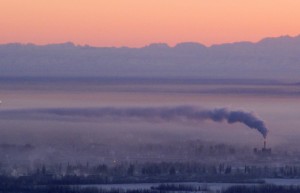Alaska bucks the global temperature trend
February 15, 2013

Ned Rozell
2/15/2013
This just in: 2012 was the coldest year of the new century in Fairbanks, and the second coldest here in the last 40 years.
Fairbanks isn’t the only chilly place in Alaska. Average temperatures at 19 of 20 long-term National Weather Service stations displayed a cooling trend from 2000 to 2010, according a recent study written up by Gerd Wendler, Blake Moore and Lian Chen of the Alaska Climate Research Center.
The rest of the world has not been going Alaska’s way. For the 36th consecutive year, the yearly global temperature in 2012 was warmer than average. That temperature, calculated from satellite data by researchers with NASA’s Goddard Institute for Space Studies, was about 58.3 degrees Fahrenheit (Fairbanks’s was 24.1 degrees F).
During the first decade of the 2000s, Alaska bucked the global warming trend, though the temperature variations were so slight you might not have noticed. Except during winter, when most of the cooling occurred. One example was the frigid January of 2012. How could you forget it in Bettles, where the average temperature was an all-time low of minus 35.6 degrees F? That’s a chilly month.
But January 2012 also featured record highs throughout the Lower 48. Almost everywhere outside of Alaska is warming. So why has Alaska been an island of cool?
“This trend was caused by a change in sign of the Pacific Decadal Oscillation,” Wendler, Blake and Chen wrote in their paper, “The First Decade of the New Century: A Cooling Trend for Most of Alaska.”
The Pacific Decadal Oscillation is a mysterious pattern of sea-surface temperatures in the North Pacific Ocean that seems to flip-flop every 20-to-30 years. The PDO influences the intensity and location of the Aleutian Low, which spins just offshore of the Alaska Peninsula. When sea-surface temperatures are relatively high in the North Pacific, the Aleutian Low is strong, causing warmer weather patterns in Alaska. We were in that groove from about 1977 to about 2000. It seems the switch has flipped to cool again.
Despite our recent trend, Alaska has for the last century warmed at about twice the rate of the rest of the globe, “as expected by the increasing CO2 and other trace gases,” Wendler and his colleagues wrote. Regarding the effect of the Pacific Decadal Oscillation, they wrote that warming “is sometimes temporarily modified or even reversed by natural decadal variations.”
How long the cooling of Alaska lasts is anyone’s guess, but if the Pacific Decadal Oscillation did indeed shift around 2000, cooler temperatures could persist in Alaska for another 20 years.
“From the ‘40s to 1976 was a cold period (caused by the Pacific Decadal Oscillation),” Wendler said. “So there’s no reason why not.”
More details from “The First Decade of the New Century: A Cooling Trend for Most of Alaska,” published in the Open Atmospheric Science Journal in 2012:
- Barrow was the only station didn’t show a cooling trend, warming 1.7 degrees Celsius during the decade of study.
- King Salmon was the other extreme, with 2.9 degrees C of cooling from 2000-2010.
- Seventy-seven percent of the cooling showed up in winter temperatures, followed by spring at 17 percent. Summer and autumn cooled only slightly — not enough to be statistically significant.
Correction: In last week’s column about the reactions of people in Sitka and Craig to a recent earthquake, I wrote that a tsunami siren in Craig was broken. Craig City Administrator Jon Bolling wrote me to say Craig has no emergency sirens, but he hopes to install some later this year.


